Trains and Other Vehicles on Rails
Electric Trains and You
A song of the season. This word might come in handy: paraphilia.Paraphilia is the experience of recurring or intense sexual arousal to atypical objects, situations, fantasies, behaviors, or individuals.[1][2] It has also been defined as a sexual interest in anything other than a consenting human partner.[
Posted By: Paul - Thu Dec 14, 2023 -
Comments (0)
Category: Holidays, Toys, Trains and Other Vehicles on Rails, 1960s, Love & Romance
British Rail’s Train Safety Experiment
Jan 1993: In order to find out how close workers could safely stand by the tracks while the new high-speed trains were going by, British Rail announced it would conduct an unusual experiment. It would tether employees to wooden posts located around six feet from the tracks and then measure the force of the slipstream on them as the trains went by at 140 mph.Although members of the public weren't invited to participate in the experiment, about 50 of them volunteered to be guinea pigs anyway.

Sunday London Telegraph - Jan 31, 1993
It was difficult to find out the results of the experiment, but after some digging I located a postscript printed in the Magazine of the Pennine Railway Society. The test never took place. Faced with widespread criticism, British Rail's Health and Safety Executive cancelled it.
Barmy BR proposed to tether workers to trackside posts as high-speed trains thundered past at 140mph. Bosses wanted human guinea pigs to stand as close as 6ft 6in to the expresses to test the effect of their slipstream. Rail
union chief Jimmy Knapp branded the idea barmy and suggested BR use Transport Secretary John MacGregor instead.
The workers would have been attached to posts by special harnesses that would allow them to move to the side but not forward. They would have been asked for their reaction after the trains had roared past. The tests would have helped to determine the distances from trains at which staff could work in safety. They would have taken place between York and Darlington.
However the Health and Safety Executive banned the scheme. The tests have been postponed pending further discussions to see how BR could get the information another way.
One disgruntled railwayman described the scheme as harebrained and said he joined BR to drive a flipping engine, not to play flipping bondage games. However a number of civilians have volunteered to take part in the scheme, preferably dressed in leather and chained from head to toe.
The effect when someone stands in the slipstream of a high-speed train is likely to be they'd get sucked under it. If tied to a post perhaps it would suck their boots off, or maybe they'd go blue in the face.
The idea is on a par to that of abolishing the timetable to stop the trains running late.
Posted By: Alex - Mon Jul 03, 2023 -
Comments (2)
Category: Experiments, Trains and Other Vehicles on Rails, Transportation, 1990s
The Pneumatic Dispatch
A detailed plan for building underground air-propelled railways.Read the whole thing here.
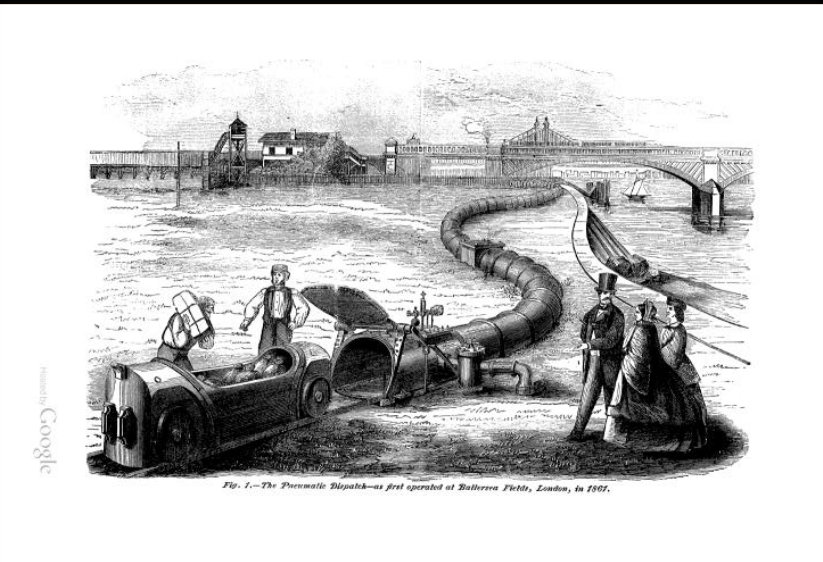
Posted By: Paul - Mon Sep 05, 2022 -
Comments (1)
Category: Inventions, Trains and Other Vehicles on Rails, Nineteenth Century
Dispatcher: The Board Game
Just as exciting as it sounds!More info here.
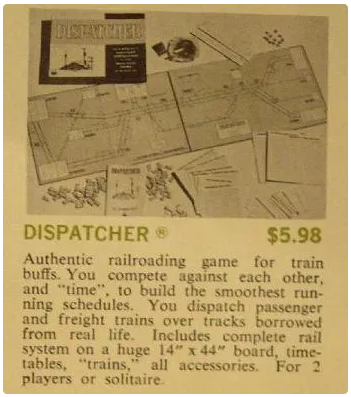
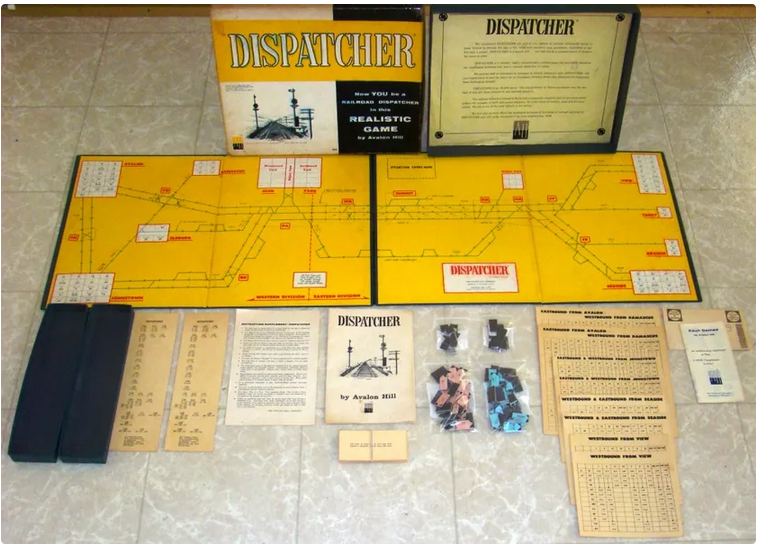
Posted By: Paul - Thu Jun 30, 2022 -
Comments (2)
Category: Boredom, Games, Trains and Other Vehicles on Rails, 1950s
Dragan Petrik’s Ice Railroad
In 1967, Dragan Petrik was granted a patent (No. 3,343,495) for a high-speed, rocket-powered train that would run on blocks of ice. In an Oct 1967 column, NY Times reporter Stacy V. Jones provided some details:Dragan R. Petrik of Pretoria was granted a patent last week for vehicles equipped to change the blocks as they melt and wear down, without stopping the train.
Patent 3,343,495 provides for propulsion by jet, rocket thrust, propellers or other means independent of the usual wheel traction. While conventional rails could be used, Petrik prefers a flanged metal surface that can be heated in cold climates.
Each car is to have cold rooms for storage of the ice. Blocks are to be forced down through ducts under control of a sensing unit that maintains the car at proper height.
Conventional wheels may be used in a station or for emergency support. A set of ice blocks is provided just ahead of and in back of each set of wheels. One ice skid can be used while another is being replenished.
For braking, there is a rubbing surface along the track, on which friction pads can be applied.
Petrik says his system will make possible very high speed for all types of land vehicles.
I have no idea if this would work, but it would be interesting to see it tested out.

Posted By: Alex - Sun Apr 17, 2022 -
Comments (2)
Category: Patents, Trains and Other Vehicles on Rails, 1960s
National Hobo Convention
The Wikipedia page.
Posted By: Paul - Mon Jan 17, 2022 -
Comments (1)
Category: Bums, Hobos, Tramps, Beggars, Panhandlers and Other Streetpeople, Conventions, Regionalism, Bohemians, Beatniks, Hippies and Slackers, Trains and Other Vehicles on Rails
Owney, the Taxidermy Post Office Dog
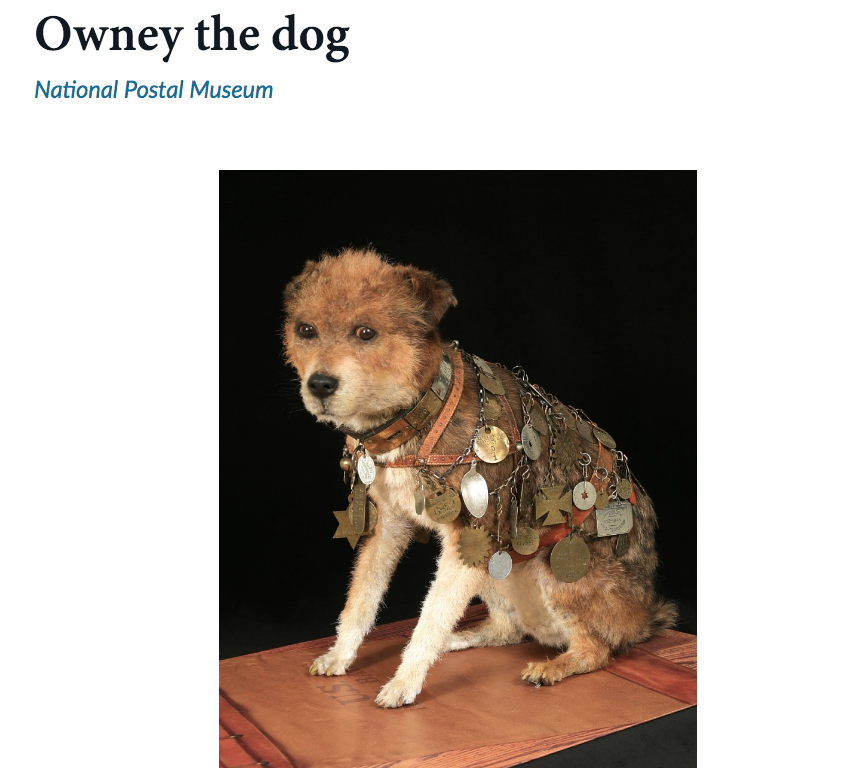
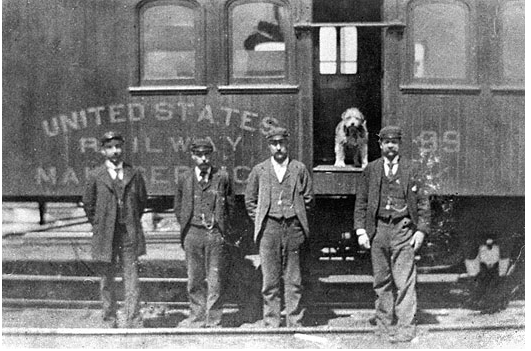
Mail clerks raised money for preserving their mascot and he was taken to the Post Office Department's headquarters in Washington, DC, where he was on placed on display for the public. In 1904 the Department added Owney to their display at the St. Louis, Missouri, World’s Fair. In 1911, the department transferred Owney to the Smithsonian Institution. In 1926, the Institution allowed Owney to travel to the Post Office Department’s exhibit at the Sesquicentennial exhibit in Philadelphia, Pennsylvania. From 1964-1992, he was displayed at the Smithsonian museum now known as the National Museum of American History and in 1993 he moved to the new National Postal Museum, where he remains on display next to a fabricated Railway Post Office train car.
Source.
Posted By: Paul - Wed Apr 28, 2021 -
Comments (0)
Category: Travel, Trains and Other Vehicles on Rails, Dogs, Nineteenth Century, Twentieth Century, Postal Services
The Soot-Bag System
In the early days of rail travel, people who had the financial means to travel first class often went third-class, to save some money. To discourage this practice some British railway companies adopted the "soot-bag system". They would hire a chimney sweep to travel in the third-class carriage and shake out the contents of his bag, getting everyone dirty. At other times, pigs and sheep were transported in the third-class carriages. The idea was to make third-class travel as unpleasant as possible.I figure that the modern-day equivalent in the airline industry is the "no-legroom system" and the "only-a-bag-of-peanuts-on-a-five-hour-flight system".
But another and apparently unforeseen consequence [of the introduction of third-class railway carriages] followed, that "certain persons in superior positions" were base enough to travel in third-class carriages. If universal indignation could have crushed these miserable creatures, they would soon have succumbed; but they persevered, even in spite of the "artificial inconveniences" specially invented to deter them. Not but what these inconveniences were serious enough.
The management of the Manchester and Leeds Railway adopted what was known as the "soot-bag system." Sweeps were hired to enter a third-class carriage which had been specially kept for the benefit of "persons in superior position," and then shake out the contents of their bags. At other times, if a correspondent of the Railway Times can be trusted, "sheep and sometimes pigs were made the substitutes for sweeps."
Even then some persons—if report said true some bailies of the City of Glasgow—persevered in their evil courses. But their conduct was strongly reprehended by all respectable persons.
Posted By: Alex - Thu Feb 11, 2021 -
Comments (5)
Category: Trains and Other Vehicles on Rails, Transportation, Nineteenth Century
Chattanooga Choo Choo, Brazilian Style
Posted By: Paul - Sat Feb 08, 2020 -
Comments (1)
Category: Costumes and Masks, Cult Figures and Artifacts, Music, Foreign Customs, Trains and Other Vehicles on Rails, 1940s, South America
Flying Body Parts Lawsuit

Ruling in what it called a "tragically bizarre" case, an appeals court found that the estate of a man killed by a train while crossing the Edgebrook Metra station tracks can be held liable after a part of his body sent airborne by the collision struck and injured a bystander.
In 2008, Hiroyuki Joho, 18, was hurrying in pouring rain with an umbrella over his head, trying to catch an inbound Metra train due to arrive in about five minutes when he was struck by a southbound Amtrak train traveling more than 70 mph.
A large portion of his body was thrown about 100 feet on to the southbound platform, where it struck Gayane Zokhrabov, then 58, who was waiting to catch the 8:17 a.m. train to work. She was knocked to the ground, her leg and wrist broken and her shoulder injured.
More details at the source.
Posted By: Paul - Mon May 20, 2019 -
Comments (1)
Category: Accidents, Body, Death, Lawsuits, Trains and Other Vehicles on Rails, Twenty-first Century

| Who We Are |
|---|
| Alex Boese Alex is the creator and curator of the Museum of Hoaxes. He's also the author of various weird, non-fiction, science-themed books such as Elephants on Acid and Psychedelic Apes. Paul Di Filippo Paul has been paid to put weird ideas into fictional form for over thirty years, in his career as a noted science fiction writer. He has recently begun blogging on many curious topics with three fellow writers at The Inferior 4+1. Contact Us |




